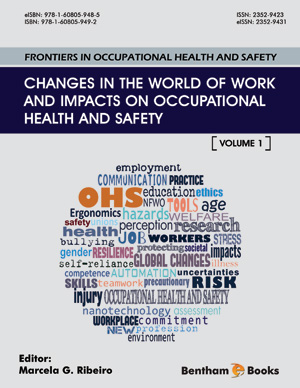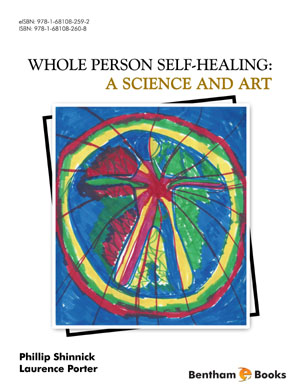Preface
Page: ii-ii (1)
Author: Chris E. Stout, Matt k and Jeffrey Rogers
DOI: 10.2174/9781608052516111010100ii
List of Contributors
Page: iii-vi (4)
Author: Chris E. Stout, Matt k and Jeffrey Rogers
DOI: 10.2174/978160805251611101010iii
Abstract
Full Text Available.
Key Words
Page: xiv-xiv (1)
Author: Chris E. Stout, Matt k and Jeffrey Rogers
DOI: 10.2174/978160805251611101010xiv
Abstract
Full Text Available.
Introduction
Page: 1-3 (3)
Author: Chris E. Stout
DOI: 10.2174/978160805251611101010001
PDF Price: $15
Abstract
This book is a novel approach to examine workers’ compensation’s various and diverse facets. The contributing authors provide a diversity of perspective and opinion that bring richness to this complex debate.
A Method and Model to Judge Evidence-Bases for Workers’ Compensation
Page: 4-10 (7)
Author: Chris E. Stout
DOI: 10.2174/978160805251611101010004
PDF Price: $15
Abstract
Application of evidence-based medicine and evidence -based practice has not yet completely migrated or been uniformly applied to clinical aspects of workers’ compensation. This chapter provides a methodology and model for readers to consider when designing and developing such an approach for their clinical practice with workers’ compensation patients.
Workers’ Compensation Care is Not the Norm: Why It Is Different
Page: 11-17 (7)
Author: Jeff Rogers
DOI: 10.2174/978160805251611101010011
PDF Price: $15
Abstract
This chapter focuses on the common theme that is brought up by some stakeholders within workers’ compensation – “Why is workers’ compensation not reimbursed at the same rate as group insurance?” Herein this author explains the difference from the perspectives of treatment provision, management, and clinicians as they relate to this topic. The perspective provided stems from the author’s experience at the “ground level” rather than from a top-down management point of view. Additionally, the differences will be explored in the form of responding to a question so that the complexity of such a topic can be more clearly understood.
For the past year, this author has been heavily involved in the revenue cycle and reimburse of all payers for a national physical rehabilitation company. The payers included group, Medicare, Medicaid, auto, personal injury and, of course, workers’ compensation. This responsibility covered a five state area and over 100 different group contracts. The result is a very non-theoretical but rather realistic perspective.
What’s Not Worked for 50 - 60 Years
Page: 18-25 (8)
Author: Matt Kruger, Jeff Rogers, Chris E. Stout and Jillian Richardson
DOI: 10.2174/978160805251611101010018
PDF Price: $15
Abstract
It seems that no one is really proud of their state’s approach of managing workers’ compensation. In fact, it furthermore seems that no one is particularly even satisfied with state’s approach of managing workers’ compensation. The irony is that “both sides” seem to feel this way, that is, those on the “side” of the injured worker as well as those on the “side” of the employer. This chapter will consider the history of workers’ compensation (in the United States) in the context of problems and attempted solutions, and it will offer one perspective as a means towards a solution.
Ethical Challenges in Working with Workers’ Compensation Patents
Page: 26-38 (13)
Author: Matt Kruger, Jeff Rogers and Chris E. Stout
DOI: 10.2174/978160805251611101010026
PDF Price: $15
Abstract
This chapter provides an intensive examination of the myriad of ethical challenges and situations that one faced (and may tempt) almost by every person involved in a workers’ compensation case—from injured employee to employer to healthcare professional to legal representatives to case managers. The chapter concludes with various real-life case examples wherein questionable ethical laps es have occurred.
Comorbidities and Workers’ Compensation: Responsive Approaches to Work Hardening and Conditioning
Page: 39-50 (12)
Author: Matt Kruger, Jeff Rogers, Chris E. Stout and Maureen Kohl Bennington
DOI: 10.2174/978160805251611101010039
PDF Price: $15
Abstract
This chapter will delve into various co-morbidities or pre-existing health/medical conditions that may negatively impact injured workers’ abilities to gain appropriate rehabilitative milestones. It is surprising to see that they so often go ignored in spite of the dramatic impact they have. This chapter also looks at various ironies and then offers Bennington’s (2010) wise ideas for ways to manage these problems. The chapter concludes with a description of a unique work hardening and conditioning program that has demonstrated efficacy.
Report of International Workers’ Compensation Survey
Page: 51-119 (69)
Author: Matt Kruger, Jeff Rogers, Chris E. Stout, Hema Burra and Jillian Richardson
DOI: 10.2174/978160805251611101010051
PDF Price: $15
Abstract
This chapter will discuss the results from a new, on line survey that is a bit unique in its scope and design that canvassed all providers involved in workers’ compensation cases. The survey’s anonymity seems to have fostered very frank responses for many respondents. Summary tables of aggregated data are provided and augmented by categorized, verbatim responses of various professionals any of which are very eye opening.
Getting Justice: The Unintended Consequences of the Dispute Resolution System
Page: 120-144 (25)
Author: Robert M. Aurbach
DOI: 10.2174/978160805251611101010120
PDF Price: $15
Abstract
The adversarial process of dispute resolution in workers’ compensation claims that occurs in most American jurisdictions creates significant costs and delays for all parties. These proceedings also have significant unintentional consequences with respect to the long-term outcomes of many injured people. Delay in case resolution, and circumstances that require the workers to repeatedly focus on their disability, tend through the mechanism of neuroplasticity, to habituate the association between physical symptoms, emotional responses and the events focusing the workers on their condition. This combination of symptoms, emotions and thoughts helps to explain why the probability of returning to full productive life drops as the length of time away from work increases. The actions of attorneys in the dispute resolution system are particularly pernicious contributors to this phenomenon. There is a discussion of some mechanisms for adjusting dispute resolution to improve outcomes.
A Respondent’s Perspective of the Workers’ Compensation System
Page: 145-150 (6)
Author: Martha Gely-Kruto
DOI: 10.2174/978160805251611101010145
PDF Price: $15
Abstract
Many factors are going to determine the outcome of a workers’ compensation case. There is a common misconception that in Illinois the system greatly favors the petitioner. Yes, the petitioner does have advantages, but in my opinion, whether you try or not the case in Illinois will have very little to do with the end result. How you approach the settlement or trial of a particular file, how good or bad your IME physician’s report is and who the injured employee is, are more significant elements of whether you win or lose a case than the jurisdiction in which you practice law. The type of relationship you have with your clients, with the claim adjusters, with the Arbitrators and your opponents will also play a role in determining the outcome of a case. Also of importance is whether you need a report from an IME physician and why, who your doctor is and what kind of report he issues can make or break your case.
Performance Based Compensation: ‘Just What The Doctor Ordered’ For Workers’ Compensation
Page: 151-165 (15)
Author: Gregory Krohm
DOI: 10.2174/978160805251611101010151
PDF Price: $15
Abstract
Medical care delivery in workers’ compensation suffers from a combination of poor incentives that promote overtreatment of injuries, particularly major surgical interventions, and shelters ineffective medical providers from quality and value based choices by purchasers. These malincentives include the lack of copayments by injured workers, the disconnection between the payer and the choice of service provider, and setting payments for services performed without regard to the effectiveness of the treatment. Finally, the selection of provider is very frequently made by the injured worker without any regard to the cost of service, and often little knowledge about the pattern of effectiveness and quality of care for that doctor. This paper focuses on the principles needed to govern a realignment of payment incentives and evidence on how well these principles have worked in the context of workers compensation medical treatment. An assessment is made of how current payment practices depart from ideal incentives for improving clinical behavior in the treatment of occupational injury.
Closing the Nightmare Claim: Practical Approaches for Ending the Most Difficult Workers’ Compensation Cases
Page: 166-173 (8)
Author: Richard W. Lenkov
DOI: 10.2174/978160805251611101010166
PDF Price: $15
Abstract
This chapter reviews the proverbial “nightmare claim,” that is claims that are problematic because they are old, complex, or perhaps involve difficult claimants, judges or attorneys. Thankfully there are ways in which to successfully manage such cases. Various closing strategies, medical strategies and legal strategies will be presented along with some key investigation steps to take from the first notice of a workers’ compensation claim. The author concludes with methods in which to manage expenses and settlement tactics as well.
Practical Application of Outcomes-Based Networks
Page: 174-179 (6)
Author: Gregory Moore
DOI: 10.2174/978160805251611101010174
PDF Price: $15
Abstract
The California MPN provides an excellent legisl ative model for managing a health-care medical network in workers’ compensation. This managed care model provides payers with the control to create and certify a medical network from which all injured employees must select physicians and medical services. This containment of patient traffic ensures higher rates of compliance in the use of approved providers than typical healthcare and workers’ compensation models.
MPNs that select providers based primarily on fee discounts may generate higher total claim costs if they provide poor quality care that results in more numerous treatments and delays returns to work. Harbor Health Systems, LLC has been engaged in a nine-year effort to develop the tools, systems, and data needed to identify providers that truly reduce total claim costs by providing superior medical care which reduces the number of treatments required for recovery and enables employees to return to work more quickly. Many practical lessons have been learned about identifying, building and managing outcomes-based network of quality providers through a pilot implementation that has produced significant positive results.
The Ethics of Clinical Guidelines and Other Tales of Evidence-Based Practice: Points and Counter-Points
Page: 180-185 (6)
Author: Joseph Paduda
DOI: 10.2174/978160805251611101010180
PDF Price: $15
Abstract
Chris Stout’s earlier chapter herein addresses issues of evidence based-practice and evidence-based medicine as applied to workers’ compensation situations , and additionally offers a model of a practice’s work-in progress in the active application of such approaches. This chapter will delve into related issues, in particular, the relatively new (to workers comp) area of comparative effectiveness, and the somewhat less sophisticated but much more common process of clinical guideline development.
The Anatomy of a Disaster Workers’ Compensation Case, How Defending a Claim Turns a Small Case into a Monster
Page: 186-190 (5)
Author: Kim Edward Presbrey
DOI: 10.2174/978160805251611101010186
PDF Price: $15
Abstract
The complexity of workers’ compensation cases can result from manifold causes—the nature of the injury and the circumstances of the injury are obvious , however there can be additional factors less obvious, like mutual suspicions of the worker and his/her employer, poor case management, misinformed expert witnesses and a myriad of other culprits that can conspire to prolong a case and maximize an untoward outcome for all parties involved. This chapter will delve into various, true-life case examples that illustrate such problems and result in so-called “nightmare cases.”
Advances in Laser Therapy for the Treatment of Work Related Injuries
Page: 191-201 (11)
Author: Brian A. Pryor
DOI: 10.2174/978160805251611101010191
PDF Price: $15
Abstract
Laser Therapy has been used as a therapeutic modality for many years and has yet to become a standard of care. This modality has great potential to be used in the clinic for the reduction of pain, inflammation and to aid in the healing process. For years many studies have been done showing the benefits of laser therapy but implementation of this technology into clinically successful products has been lagging behind. This chapter will briefly review the science behind laser therapy, the traditional systems which were used and new technologies, Class IV lasers, now being used to treat injuries seen in the work place. New advances in this technology are being made which are leading to improved and consistent clinical outcomes. The mechanisms of action for pain relief, reduction of edema and tissue healing will be presented as well as important parameters to use in order to succeed when choosing this exciting therapeutic modality. Included are brief reviews of laser therapy when treating epicondylitis, carpal tunnel syndrome, neck and back pain as well as in post surgical rehabilitation applications. Laser therapy is a tool which can have great benefit when treating both acute stage injuries as well improving some chronic conditions.
Persistent Problems in Clinical Practice
Page: 202-208 (7)
Author: Peter Rousmaniere
DOI: 10.2174/978160805251611101010202
PDF Price: $15
Abstract
Medical care accounts for 60% of the total cost of workers compensation claims. Claims that payers under invest in medical intelligence, thereby allowing medical errors and sub-optimal treatment to happen more than they need to be. However, structural, system-wide factors are behind some of the persistent problems in clinical practice. Systemic problems persist in making assessments of work causality of injury and in estimating permanent impairment. States have since the early 1990s erected a complex structure of managed care practices, however, they are flawed in a number of ways, and claims payers fail to implement them as comprehensively as they could. Claims are in a position to invest more in medical intelligence to encourage and facilitate improvements in clinical practice .
How Medical Practice Patterns Vary for Low Back Conditions
Page: 209-221 (13)
Author: Dongchun Wang, Kathryn L. Mueller, Dean Hashimoto, Sharon Belton and Richard A. Victor
DOI: 10.2174/978160805251611101010209
Abstract
Back pain is a common source of disability, both from work-related injuries and from injuries that occur outside the workplace. Annually in the United States, over $15 billion is spent for the treatment of low back pain and disorders, and approximately 15 percent of the costs in workers’ compensation medical care are for low back pain cases. This study focuses on care provided or directed by physicians and addresses the following questions: What are the patterns of medical care for workers with common low back conditions in the 16 states studied? How do these patterns vary across states? How do the patterns of medical practice in the study states compare with evidence-based treatment guideline recommendations? Overall, we found that workers with similar low back conditions received very different care, depending on the state. These interstate differences were most noticeable for cases with nonspecific low back pain in the areas of diagnostic services and pain management injections. For disc cases, the interstate differences were most notable in the utilization of nerve testing, pain management injections, back surgery, and physical medicine. Large interstate differences in the timing of care were also seen for both types of low back conditions.
Appendix-A (APTA Workers' Compensation State Resource Guide)
Page: 222-232 (11)
Author: Chris E. Stout, Matt Kruger and Jeffrey Rogers
DOI: 10.2174/978160805251611101010222
PDF Price: $15
Abstract
Full Text Available.
Appendix B (Survey Questionnaire)
Page: 233-239 (7)
Author: Chris E. Stout, Matt Kruger and Jeffrey Rogers
DOI: 10.2174/978160805251611101010233
PDF Price: $15
Abstract
Full Text Available.
Appendix C (Fee Schedules for Workers’ Compensation)
Page: 240-244 (5)
Author: Chris E. Stout, Jeffrey Rogers and Matt Kruger
DOI: 10.2174/978160805251611101010240
PDF Price: $15
Abstract
Full Text Available.
Appendix D (Workers’ Compensation Publication List)
Page: 245-248 (4)
Author: Chris E. Stout, Jeffrey Rogers and Matt Kruger
DOI: 10.2174/978160805251611101010245
PDF Price: $15
Abstract
Full Text Available.
Author Index
Page: 249-251 (3)
Author: Chris E. Stout, Jeffrey Rogers and Matt Kruger
DOI: 10.2174/978160805251611101010249
Abstract
Full Text Available.
Subject Index
Page: 252-255 (4)
Author: Chris E. Stout, Jeffrey Rogers and Matt Kruger
DOI: 10.2174/978160805251611101010252
Abstract
Full Text Available.
Introduction
This ebook integrates all aspects of medical care relevant to worker compensation. It explains benefits of the application of evidence-based approaches to worker compensation care. Improved outcomes of such approaches include less risky treatments, faster healing, and good return to work experience. It also points towards designing a better health care system with a focus on the economy, healthcare policy and change, and growing innovation in medical practice. The ebook should serve as a significantly important reference tool for several working professionals in healthcare systems as well as for students and trainees.












